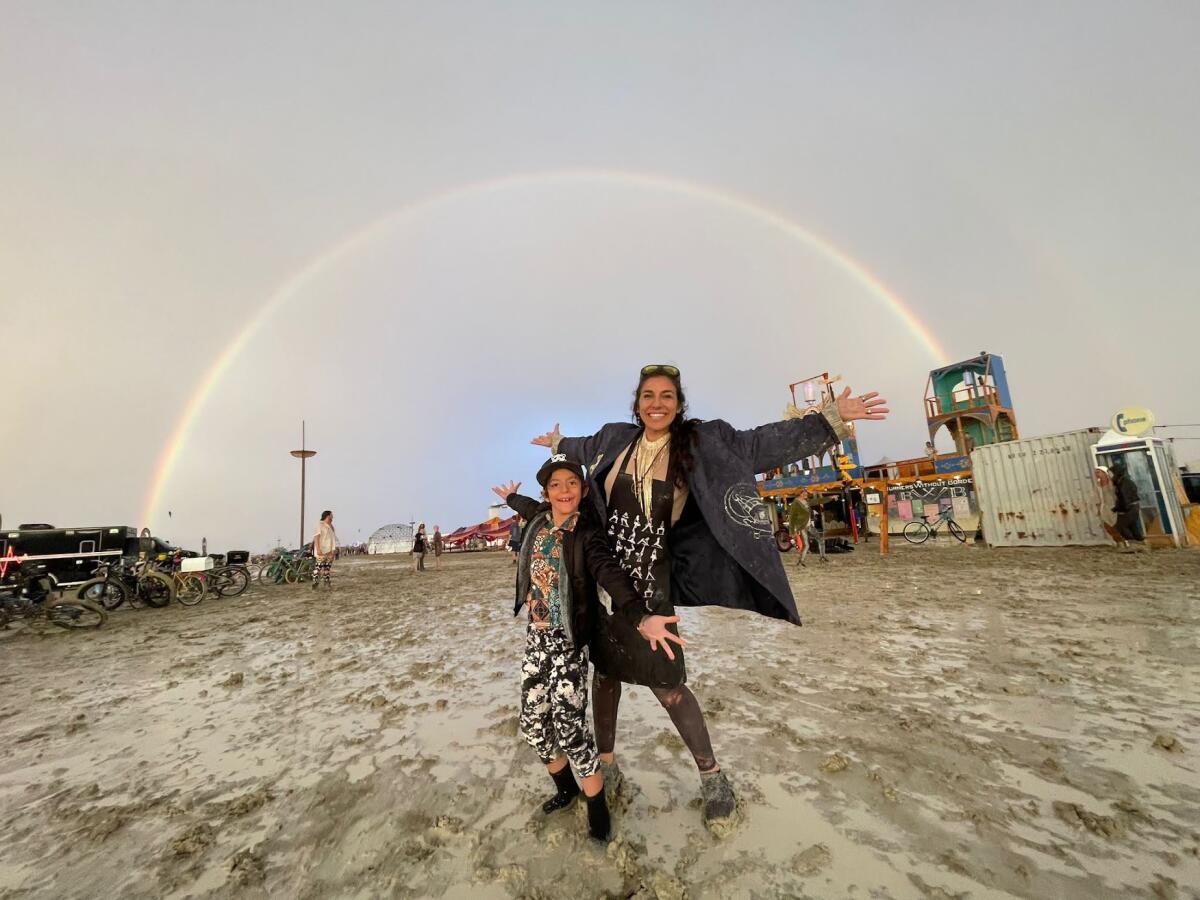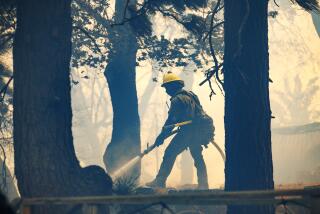‘This is the burn we signed up for’: Some Burning Man festival-goers refuse to let rain spoil their fun

The phone calls started Saturday morning and didn’t stop.
Burbank helicopter charter operator Ivan Arnold was inundated with calls from partygoers at the Burning Man festival in northwestern Nevada. Heavy rains had turned the desert site into a swamp, stranding thousands.
“They’re frantic, they’re crying, saying, ‘Get me out of here!’” Arnold said.
A hedonistic celebration on the dusty flatlands, Burning Man turned into a soggy but spirited mess this year. Rainstorms doused the annual festival at Black Rock Desert while also causing road closures and rescues across the state.
Authorities on Sunday were investigating the death of one festival-goer. According to a spokesperson, the fatality was not related to the weather: “Our emergency services department reached a call for service extremely quickly for a male, approximately 40 years old, and could not resuscitate the patient.”
Meanwhile, by Sunday evening, weather conditions were improving at Burning Man, according to a news release, but “roads in Black Rock City remain too wet and muddy to officially open them for Exodus.” The traditional leave-taking was postponed to Monday morning “as long as conditions improve. We will inform the community as soon as we make the decision as to the route and the timing.”
Earlier in the day, Arnold — who helped deliver supplies to San Bernardino Mountains residents trapped by snowstorms earlier this year — wanted to offer free rides to high-risk people stuck at the festival.
But he was told there was no air traffic of any kind allowed in the area.
Burning Man organizers reported the festival site received 0.6 to 0.8 of an inch of rain between Friday night and Saturday morning. On Sunday morning, the area was unusually cool.
The mud trapped cars and made bikes, a popular tool for partygoers in the desert, unusable. Organizers asked festival-goers to stay in their RVs and tents.
Officials also closed all roads in and out of the festival grounds. Some vehicles managed to plow through the mud, officials said, but there was damage to the playa surface.
Those hoping to watch the incineration of the festival’s eponymous wooden effigy Saturday night were disappointed: The soggy weather postponed the climactic ceremony to Monday night.
The nine-day festival — which celebrates “community, art, self-expression and self-reliance” — typically draws tens of thousands of people to Nevada. The Reno Gazette-Journal reported over the weekend that more than 73,000 people were at this year’s festival.
Organizers said that they planned to drop mobile cell trailers around the festival site so attendees could call loved ones and check in with employers. Burning Man Information radio, a station for festival-goers, also broadcast guidance throughout the weekend.
“Please do not climb on the art!” an announcer said on Sunday, referring to giant sculptures erected by festival organizers. “There are muddy unsafe conditions on playa and very limited mobile emergency services available right now [at the festival site].”
Karole Holland-Hagino, who was attending her first festival with her son, said she was in a camp with about 125 people, and although the rain and mud made it hard to walk, she strolled the grounds for about four hours Saturday, barefoot.
She dismissed social media rumors of virus outbreaks at the festival, saying there was no truth to them “at all” and everyone was “healthy and happy.”
“I gotta go ... party time,” she texted. “Everyone is great and everyone adapting.”
An individual going by the name “Jenn the Burner Nurse” on TikTok told The Times that she had stayed in her camp since Friday night and advised other attendees to do the same.
She described the weather conditions as “less than optimal” but said the atmosphere wasn’t as dire as suggested in media reports.
“So far people are doing well,” she said. “There are camps still serving food and have an open bar. Burners are in good spirits and helping each other out however possible.”
Lyn Ventimiglia, 29, said she sent her husband off to his first Burning Man festval in an RV with nine friends, confident he was about to have the time of his life.
“This is something he saved up for and that he’s wanted to do for many years,” hoping to follow in the footsteps of his late father, who was at the Woodstock music festival in 1969, she said.
For those who stick to a shoestring budget, “it’s no more than if you look at people buying Beyoncé tickets and Taylor tickets,” she said.
But those same attendees were hard hit by the storm, with little means to communicate with the outside world. Ventimiglia said her husband contacted her on Saturday.
“He texted me saying, ‘Love you, crisis situation,’” she said. “He either bartered or bought internet for 15 [minutes] to get in contact with me. When I spoke to him, he definitely seemed a little bit discouraged and worried, but he kept saying, ‘Don’t worry, I’m gonna be OK.’
“I know this whole concept of self-reliance is a huge thing at Burning Man, but I really hope they are not letting all their attendees fend for themselves,” Ventimiglia said.
Burning Man began as a celebration of the summer solstice with a small effigy on the foggy shores of Baker Beach in San Francisco in 1986.
By the early 1990s, it had evolved into an annual counterculture event — part art festival, part social experiment — on a dry lake bed in the Black Rock Desert of Nevada, about 100 miles outside Reno.
The festival is remote by design: five miles from the nearest paved road, three hours from the nearest airport, with infrastructure for 70,000 people that is built and unbuilt over the course of a few weeks every year.
Though its ethos is “radical self-reliance,” it’s best known for its ephemeral art installations, Mad Max meets Bay to Breakers couture and all-night dance parties fueled by hallucinogenic drugs.
It culminates on the Saturday night before Labor Day, when a towering wooden man is set aflame. In recent years, Burning Man has become a Silicon Valley rite of passage. With its growing popularity among the tech elite, the party has become less DIY and more plug-and-play, with well-heeled festival-goers spending thousands apiece on tickets, supplies and “camp fees” for showers, hot food and electricity.
Unpredictable weather conditions — storm, winds and dust — aren’t uncommon.
Still, the inclement weather blanketed parts of the state. Heavy rain closed portions of Interstate 15 on Saturday along the California-Nevada border, a major artery for Las Vegas-bound travelers that is often busiest during holiday weekends.
Las Vegas firefighters reported on Saturday that it responded to 23 swift-water rescue events and that more than 30 vehicles were stranded in water.
The area east of downtown Las Vegas received more than three inches over Friday and Saturday, said Brian Planz, a meteorologist with the National Weather Service in Las Vegas.
The rain is a result of a monsoon, a weather pattern that occurs over the southwest U.S. typically in June through September.
A low-pressure weather system off the California coast was helping pull up additional moisture from the south, Planz said.
By Sunday evening, the majority of the rain had passed to the east, with a slight chance of showers into the night — but Monday was expected to bring clear skies “and a welcome chance to dry out,” said spokesperson Dominique Debucquoy-Dodley.
Some decided not to wait for the better weather.
DJ and music producer Diplo, who performed at the festival, was among those who decided to get out.
He endured a miles-long muddy walk before a passing truck driver offered him and comedian Chris Rock a ride, according to a video he posted on social media.
Festival-goer Bianca Snyder said her 7-year-old son, Tage, wasn’t deterred by the rain.
“Kids love playing in puddles, so it’s just trying to keep the number of outfits that we destroy in mud-puddles limited to one a day,” said Snyder, who lives in Chicago. “But he’s a kid, so he’s having a blast.”
Tage, who is at his fifth “burn” — a shorthand name for the festival — is just waiting for the ground to dry out so he can cruise around Black Rock City on his bike again, she added.
Dallas businessman Sean Rakidzich has been in the Black Rock Desert since the middle of last week helping to set up camp, and has been running the kitchen for Exclamation Mark, a $320-per-person campsite near the center of “The Playa.”
Rakidzich said parties were still raging and he had to rework the menu to stretch food into the coming week and to feed people who were rained out of their own campsites and had come seeking shelter.
Still, festival-goers in the larger camps were more prepared, he said. “It’s a big camp’s responsibility to step up and help the people in the free camp,” he said.
He said he didn’t think the flooding would dampen next year’s event, but that it might draw a different crowd.
“Adversity will drive away people who think Burning Man is a music festival,” he said. “A lot of us do believe that this is the burn we signed up for.”
More to Read
Sign up for Essential California
The most important California stories and recommendations in your inbox every morning.
You may occasionally receive promotional content from the Los Angeles Times.












